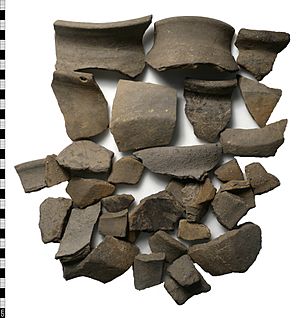Ipswich ware facts for kids
Ipswich ware is a special kind of pottery made in Britain a long time ago. It was made by the Anglo-Saxon people between the 700s and 800s AD. This pottery was mostly made in the Ipswich, Suffolk area. It's important because it was the first pottery in Britain after the Romans left that was made using a spinning wheel. It was also the first pottery made in large amounts. Ipswich ware is usually plain, hard, and grey. People used it for jars, cooking pots, and sometimes fancy pitchers. It was mostly sold in eastern Britain, but some pieces traveled far, even to York and Oxfordshire.
Contents
What Ipswich Ware Looks Like
Ipswich ware is a simple, strong, and sandy grey pottery. It can feel smooth or a bit rough. The color is usually dark grey.
This pottery came in a few main shapes:
- Jars with round bodies and straight tops.
- Pots that could be hung up.
- Cooking pots.
- Sometimes, large bottles and pitchers with decorations.
The bottom of the jars was often very thick. The top parts of the jars sometimes had lines carved into them. Potters made this pottery using a slow spinning wheel, like a turntable. Then, they baked it in a hot oven called a kiln.
Ipswich ware is similar to pottery from Friesland, a place in Europe. Frisian pottery was also grey, round, and thick. It was also made on a spinning wheel.
The History of Ipswich Ware
Ipswich ware was the first pottery in Britain to be made on a wheel and produced in large numbers after the Roman Empire ended. It was made from the early 700s to the 800s AD.
It was very popular in eastern Britain, especially in East Anglia and eastern Cambridgeshire. People also traded it to other places, like Kent, north to York, and west to Oxfordshire. This trading often happened along busy travel routes.
Before Ipswich ware, from the 500s to the 700s AD, most pottery in Britain was made by hand. It was often baked in open bonfires. But in Ipswich, around the early 700s, local potters changed their methods. They started using a slow spinning wheel to finish their pots. Then, they baked them in special ovens called kilns.
Discovering Ancient Kilns
Archaeologists have found three pottery kilns from the Anglo-Saxon time in Ipswich. Two kilns were found in an area called Cox Lane. Another kiln was found in the Buttermarket area.
These discoveries show that Ipswich ware was first made around 720 AD. It seems that potters first shaped the clay by coiling it, then finished it on a slow wheel, and finally baked it in a kiln. The kiln found in Buttermarket was used from 800 to 850 AD. After Ipswich ware became popular, people in Britain mostly stopped making pottery by hand.
See also
- Sandy ware
- Shelly ware
- Thetford ware
- List of English medieval pottery


